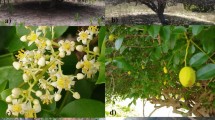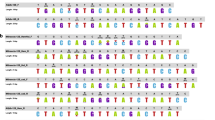Abstract
The appropriateness of the Amplified Fragment Length Polymorphism (AFLP) technique for investigating Chondrus crispus Stackhouse populations in the Maritime Provinces of Canada was assessed. The AFLP procedure was first subjected to reproducibility testing and three shortcomings were noted: 1) failure to reproduce band intensity between replicate runs for the same individual and primer pair; 2) failure of some bands to replicate; 3) lack of reproducibility for complete replicate runs for some individuals and primer pairs. In the last-mentioned case, the lack of reproducibility resulted in characteristic electropherograms indicative of weak reactions. These weak runs can be attributed to poor restriction digest/ligation reactions and/or substandard PCR, these failures ultimately resulting from low and inconsistent DNA quality. We recommend that reproducibility testing should be completed routinely in studies using the AFLP technique. In the current work, only fragments and individuals that gave reproducible results were used in subsequent analyses. The AFLP method resulted in highly variable markers within and between the populations of C. crispus included in this investigation, which prevented successful resolution of population structure. This situation could result from a lack of suitability for AFLP markers in population genetic studies, and/or too extensive genetic variation for C. crispus populations to be discerned by the AFLP technique. These two possible explanations are discussed.
Similar content being viewed by others
References
Cheney DP, Babbel GR (1978) Biosystematic studies of the red algal genus Eucheuma. I. Electrophoretic variation among Florida populations. Mar. Biol. 47: 251-264.
Cheney DP, Mathieson AC (1979) Population differentiation in the seaweed Chondrus crispus: preliminary results. Isozyme Bull. 12: 57.
Chopin T, Bird CJ, Murphy CA, Osborne JA, Patwary MU, Floc'h JY (1996) A molecular investigation of polymorphism in the North Atlantic red alga Chondrus crispus (Gigartinales). Phycol. Res. 44: 69-80.
Dice LR (1945) Measures of the amount of ecologic association between species. Ecology 26: 297-302.
Donaldson SL, Chopin T, Saunders GW (1998) Amplified Fragment Length Polymorphism (AFLP) as a source of genetic markers for red algae. J. appl. Phycol. 10: 365-370.
Dowling TE, Moritz C, Palmer JD (1990) Nucleic Acids II: Restriction Site Analysis: 250-317. In Hillis DM, Moritz C (eds.), Molecular Systematics. Sinauer Associates Ltd., Sunderland, 588 pp.
Felsenstein J (1985) Confidence limits on phylogenies: an approach using the bootstrap. Evolution 39: 783-391.
Folkertsma RT, Rouppe van der Voort JNAM, de Groot KE, van Zandvoort PM, Schots A, Gommers FJ, Helder J, Bakker J (1996) Gene pool similarities of potato cyst nematode populations assessed by AFLP analysis. Mol. Plant-Micr. Int. 9: 47-54.
Goff LJ, Moon DA, Nyvall P, Stache B, Mangin K, Zuccarello G (1996) The evolution of parasitism in the red algae: molecular comparisons of adelphoparasites and their hosts. J. Phycol. 32: 297-312.
Hillis DM, Bull JJ (1993) An empirical test of bootstrapping as a method for assessing confidence in phylogenetic analysis. Syst. Biol. 42: 182-192.
Hongtrakul V, Huestis GM, Knapp SJ (1997) Amplified fragment length polymorphisms as a tool for DNA fingerprinting sun-flower germplasm: genetic diversity among oilseed inbred lines. Theor. appl. Genet. 95: 400-407.
Jones CJ, Edwards KJ, Castaglione S, Winfield MO, Sala F, van de Wiel C, Bredemeijer G, Vosman B, Matthes M, Daly A, Brettschneider R, Bettini P, Buiatti M, Maestri E, Malcevschi A, Marmiroli N, Aert R, Volckaert G, Rueda J, Linacero R, Vasquez A, Karp A (1997) Reproducibility testing of RAPD, AFLP and SSR markers in plants by a network of European laboratories. Mol. Breed. 3: 381-390.
Kardolus JP, van Eck HJ, van den Berg RG (1998) The potential of AFLPs in biosystematics: a first application in Solanum taxonomy (Solanaceae). Pl. Syst. Evol. 210: 87-103.
Keim P, Kalif A, Schupp J, Hill K, Travis SE, Richmond K, Adair DM, Hugh-Jones M, Kuske CR, Jackson P (1997) Molecular evolution and diversity in Bacillus anthracis as detected by Amplified Fragment Length Polymorphism markers. J. Bact. 179: 818-824.
Kessler LG, Avise JC (1985) A comparative description of mitochondrial differentiation in selected avian and other vertebrate genera. Mol. Biol. Evol. 2: 109-126.
Koch G, Jung C (1997) Phylogenetic relationships of industrial chicory varieties revealed by RAPDs and AFLPs. Agronomie 17: 323-333.
Lin J-J, Kuo J, Ma J (1996) A PCR-based DNA fingerprinting technique: AFLP for molecular typing of bacteria. Nucl. Acids Res. 24: 3649-3650.
Maniatis T, Fritsch EF, Sambrook J (1982) Molecular Cloning: A Laboratory Manual. Cold Spring Harbor Laboratory, New York.
Mizukami Y, Kito H, Kunimoto M, Kobayashi M (1998) Effect of DNA preparation from laver (Porphyra yezoensis) thalli on reproducibility of RAPD (Random Amplified Polymorphic DNA) patterns. J. appl. Phycol. 10: 23-29.
Nei M (1987) Molecular Evolutionary Genetics. Columbia University Press, New York, 512 pp.
Nei M, Li W-H (1979) Mathematical model for studying genetic variation in terms of restriction endonucleases. Proc. Nat. Acad. Sci. USA 76: 5269-5273.
Rohlf FJ (1993) NTSYS-pc version 1.8. Numerical Taxonomy and Multivariate Analysis System. Exeter Software, New York.
Rosendahl S, Taylor JW (1997) Development of multiple genetic markers for studies of genetic variation in arbuscular mycorrhizal fungi using AFLP. Mol. Ecol. 6: 821-829.
Saitou N, Nei M (1987) The neighbor-joining method: a new method for reconstructing phylogenetic trees. Mol. Biol. Evol. 4: 406-425.
Saunders GW (1993) Gel purification of red algal genomic DNA: an inexpensive and rapid method for the isolation of polymerase chain reaction-friendly DNA. J. Phycol. 29: 251-254.
Swofford DL (1999) PAUP*. Phylogenetic Analysis Using Parsimony (* and other methods). Version 4. Sinauer Associates, Sunderland, Massachusetts.
Travis SE, Maschinski J, Keim P (1996) An analysis of genetic variation in Astragalus cremnophylax var. cremnophylax, a critically endangered plant, using AFLP markers. Mol. Ecol. 5: 735-745.
Upholt WB (1977) Estimation of DNA sequence divergence from comparison of restriction endonuclease digests. Nucl. Acids Res. 4: 1257-1265.
Vos P, Hogers R, Bleeker M, Reijans M, van de Lee T, Hornes M, Frijters A, Pot J, Peleman J, Kuiper M, Zabeau M (1995) AFLP: a new technique for DNA fingerprinting. Nucl. Acids Res. 23: 4407-4414.
Vos P, Kuiper M (1997) AFLP analysis: 115-131. In Caetano-Anollés G, Gressholf PM (eds.), DNA markers: Protocols, applications and overviews. Wiley-VCH, New York, 364 pp.
Welsh J, McClelland M (1990) Fingerprinting genomes using PCR with arbitrary primers. Nucl. Acids Res. 18: 7213-7218.
Winfield MO, Arnold GM, Cooper F, Le Ray M, White J, Karp A, Edwards KJ (1998) A study of genetic diversity inPopulus nigra subsp. betulifolia in the Upper Severn area of the UK using AFLP markers. Mol. Ecol. 7: 3-10.
Zabeau M, Vos P (1993) Selective restriction fragment amplification: a general method for DNA fingerprinting. European Patent Application No.: 92402629.7. Publication Number EP 0534858 A1.
Author information
Authors and Affiliations
Rights and permissions
About this article
Cite this article
Donaldson, S.L., Chopin, T. & Saunders, G.W. An assessment of the AFLP method for investigating population structure in the red alga Chondrus crispus Stackhouse (Gigartinales, Florideophyceae). Journal of Applied Phycology 12, 25–35 (2000). https://doi.org/10.1023/A:1008178309493
Issue Date:
DOI: https://doi.org/10.1023/A:1008178309493




